Your living room serves as the heart of your home where family gatherings unfold and memories take shape. Whether you’re starting from scratch or refreshing your current space, the right decor choices can transform an ordinary room into an extraordinary sanctuary that reflects your personality and lifestyle.
We understand that decorating your living room can feel overwhelming with countless styles, colors, and furniture options competing for your attention. From modern minimalist approaches to cozy farmhouse vibes, the possibilities seem endless. That’s why we’ve curated practical and inspiring ideas that work for any budget and space size.
Ready to create a living room that impresses guests and provides daily comfort for your family? We’ll guide you through proven design strategies that combine functionality with stunning aesthetics, helping you achieve the perfect balance between style and livability.
Choose a Cohesive Color Scheme That Sets the Mood
Color choices transform your living room from a basic space into a personalized sanctuary that reflects your style. We’ve found that selecting the right color scheme creates the foundation for all other decorating decisions in your room.
Select a Primary Color Palette
Neutral foundations work best for creating timeless living room appeal. We recommend starting with three main colors that complement each other naturally. Classic combinations like warm whites, soft grays, and cream tones provide versatility for future decor changes.
Bold primary palettes make striking statements in confident homes. Deep navy blue paired with crisp white and warm brass accents creates sophisticated coastal vibes. Rich emerald green combined with charcoal gray and gold touches delivers luxurious elegance.
Monochromatic schemes offer sophisticated simplicity for modern spaces. Various shades of the same color family create depth without overwhelming smaller rooms. Light blue walls with medium blue furniture and dark blue accessories maintain visual harmony while adding dimension.
Add Accent Colors for Visual Interest
Strategic accent placement prevents monotonous color schemes in living spaces. We suggest limiting accent colors to two complementary shades that appear in 10-20% of your room’s elements. Throw pillows, artwork, plants, and decorative objects serve as perfect accent vehicles.
Seasonal accent swaps keep your living room feeling fresh throughout the year. Warm oranges and deep reds energize autumn gatherings while cool blues and crisp whites refresh summer entertaining. This approach costs less than major redecorating while maintaining visual interest.
Metallic accents bridge different color temperatures in challenging spaces. Brass fixtures warm up cool gray palettes while chrome details complement cooler blue schemes. Mixed metals work when you maintain consistent undertones across all metallic elements.
Consider the Psychology of Colors
Warm colors stimulate conversation and create inviting gathering spaces. Reds, oranges, and yellows increase energy levels and encourage social interaction during family time. These hues work particularly well in formal living rooms designed for entertaining guests.
Cool colors promote relaxation and peaceful evening routines. Blues, greens, and purples lower stress levels and create calming environments for reading or quiet activities. We recommend these shades for family rooms where you unwind after long workdays.
Earth tones establish grounding connections with natural elements. Browns, taupes, and warm beiges create stable foundations that pair beautifully with wooden furniture and natural textures. These colors work especially well in homes with abundant natural light and outdoor views.
Maximize Natural Light and Layer Your Lighting Design
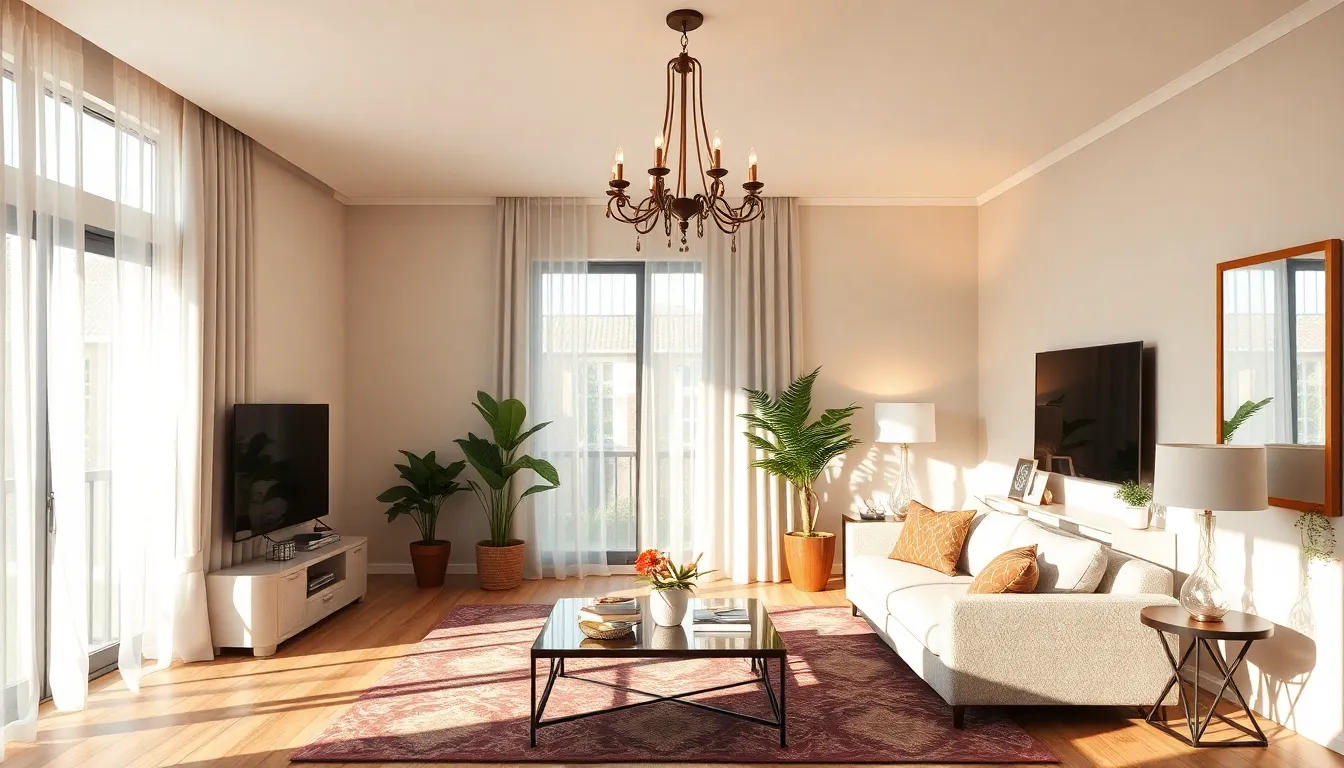
Natural light transforms our living spaces into brighter, more welcoming environments while strategic artificial lighting creates the perfect ambiance for any occasion.
Optimize Window Treatments for Light Control
Sheer curtains offer the perfect balance between privacy and illumination. These lightweight fabrics filter harsh sunlight while allowing maximum natural light to flow throughout our living room. We can install adjustable blinds or layered window treatments that provide complete control over light levels throughout the day.
Adjustable window treatments help us maintain a cozy atmosphere by filtering intense sunlight. Roman shades, plantation shutters, and dual-layer curtain systems allow us to fine-tune the amount of light entering our space. This flexibility ensures we can create the ideal lighting conditions for reading, entertaining, or relaxing.
Install Multiple Light Sources at Different Heights
Layered lighting incorporates overhead fixtures, table lamps, and floor lamps to create comprehensive illumination. We should combine ceiling fixtures like chandeliers or recessed lights with mid-level table lamps and tall floor lamps to establish visual interest. This approach ensures our room is well-lit without creating harsh shadows or overly bright spots.
Different lighting heights serve various purposes throughout our living space. Task lighting from table lamps provides focused illumination for reading or crafts, while ambient lighting from ceiling fixtures offers general room illumination. Accent lighting from sconces or decorative string lights adds character and creates focal points that enhance our room’s personality.
Use Mirrors Strategically to Reflect Light
Mirrors placed opposite windows amplify natural light by reflecting it deeper into our living room. Large wall mirrors or decorative mirror collections create the illusion of additional windows while doubling the impact of existing natural light sources. We can position mirrors at angles that capture and redirect sunlight to darker corners of our space.
Reflective surfaces beyond traditional mirrors also enhance our room’s brightness. Metallic picture frames, glass coffee tables, and glossy ceramic accessories all contribute to light reflection throughout our living area. These elements work together to create a brighter, more spacious feel that makes our room appear larger and more inviting.
Create a Functional Furniture Layout That Promotes Flow

Strategic furniture placement transforms your living room into a welcoming space that naturally guides movement while encouraging conversation. We’ll show you how to arrange your furniture for optimal flow and functionality.
Position Your Sofa as the Room’s Anchor
Identify your room’s focal point first—whether it’s a fireplace, large window, or entertainment unit—then position your sofa to face this feature directly. Your sofa becomes the spatial anchor that defines the room’s orientation and establishes the foundation for all other furniture placement.
Place your sofa at the optimal distance from the focal point to create visual balance without overwhelming the space. We recommend positioning it far enough to appreciate the focal feature while maintaining comfortable viewing angles for activities like watching TV or enjoying a fireplace.
Consider the sofa’s relationship to natural light sources when determining its final placement. Positioning your main seating to take advantage of windows creates an inviting atmosphere while preventing glare issues during different times of day.
Add Secondary Seating Options
Create conversation areas by placing armchairs or accent chairs to face your main sofa either directly across or at strategic angles. This arrangement facilitates natural dialogue while adding visual interest to your furniture layout.
Maintain conversational distance by keeping seating elements between 3.5 to 10 feet apart, allowing people to chat comfortably without shouting across the room or feeling crowded together.
Position secondary seating around coffee tables or near focal points to reinforce the room’s purpose and create multiple gathering spots. These additional seating options provide flexibility for different activities and group sizes.
Mix furniture heights and shapes to create visual balance throughout the space. Flank low sofas with taller elements like floor lamps or plants, and incorporate rounded tables or curved chairs to soften angular arrangements.
Ensure Clear Pathways Throughout the Space
Allow 18–24 inches minimum between large furniture pieces for basic walkways, though 30–36 inches provides optimal comfort and prevents the space from feeling cramped.
Map natural traffic patterns from entry points to seating areas, ensuring people can move freely from one end of the room to another without handling around obstacles.
Create unobstructed routes to frequently used areas like doorways, windows, and entertainment centers. Clear pathways support both daily functionality and the visual harmony of your living room layout.
Test your layout by physically walking through the space to identify any bottlenecks or awkward turns that might disrupt the natural flow of movement.
Incorporate Texture and Pattern for Visual Depth
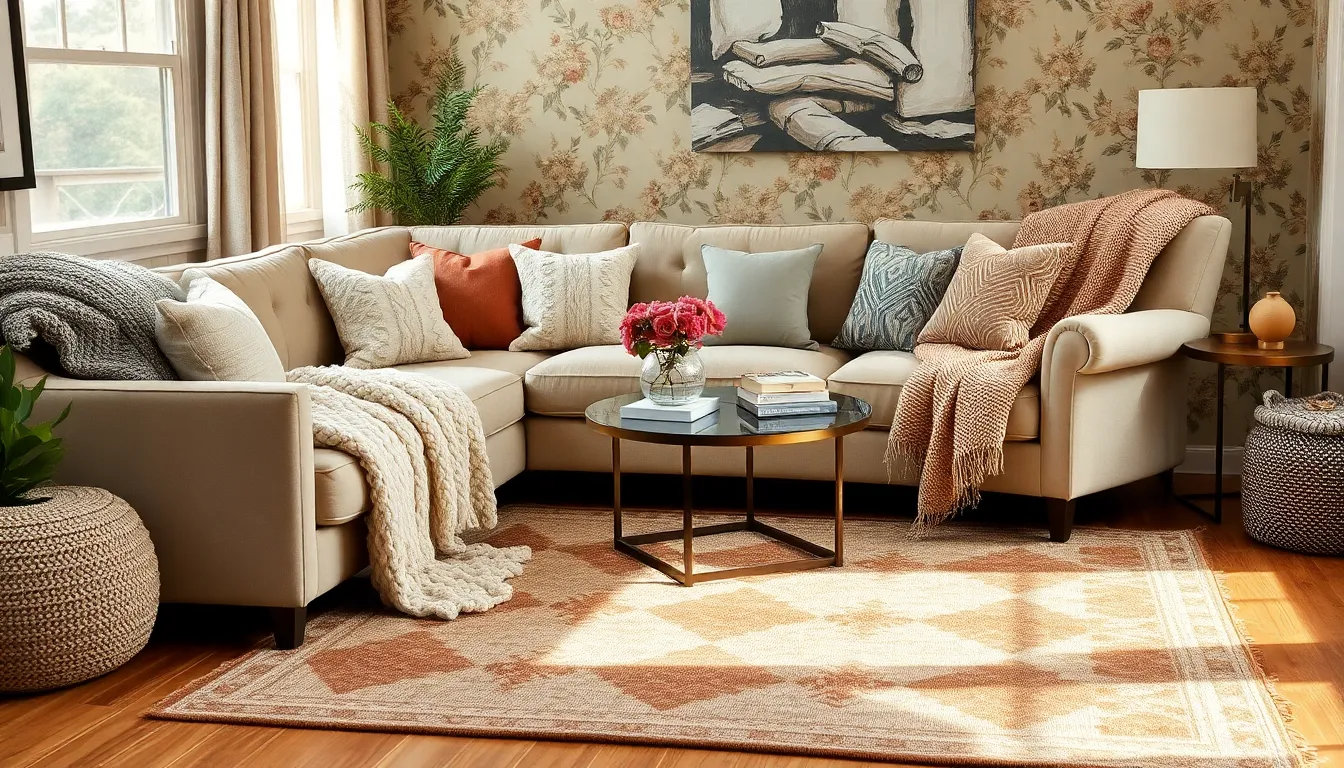
We can transform our living room into a sophisticated space by layering different textures and patterns that create visual interest without overwhelming the room.
Mix Different Fabric Textures
Mixing fabric textures adds depth and invites touch while creating visual contrast throughout our living space. We recommend pairing a plush velvet sofa with a linen armchair to achieve this layered aesthetic that enhances comfort and style. Combining materials like velvet, linen, wool, and tile creates a rich tapestry of surfaces that makes the room feel more inviting and luxurious.
Contrasting textures encourage exploration and make our seating area more captivating for both family and guests. We can introduce chunky knit throws over smooth leather furniture or place silk pillows against rough burlap cushions. These combinations create tactile experiences that elevate the overall design while maintaining visual balance.
Layer Rugs for Warmth and Definition
Layering rugs creates cozy warmth while defining distinct areas within our living room layout. We can place a smaller patterned rug over a larger neutral one to establish visual boundaries and add personality to our space. This technique works particularly well in open floor plans where we need to separate the seating area from other functional zones.
Choosing rugs with complementary colors and varying textures helps create depth beneath our furniture arrangement. We suggest starting with a solid or neutral foundation rug and adding a smaller accent piece with bold patterns or rich textures on top. This approach provides flexibility to change seasonal accents without replacing the entire floor covering.
Combine Patterns at Various Scales
Combining patterns at different scales prevents visual chaos while maintaining captivating design throughout our living room. We can pair large scale floral wallpaper with medium sized geometric throw pillows and small delicate striped curtains to create balanced visual rhythm. This mix of pattern sizes keeps the eye interested without creating overwhelming competition between design elements.
Using neutral backgrounds like soft beige walls helps balance bold pattern combinations and provides visual rest areas. We recommend limiting ourselves to three different pattern scales within the same color family to maintain cohesion. Starting with one dominant large pattern and supporting it with smaller complementary designs creates hierarchy and prevents the space from feeling cluttered or chaotic.
Add Personal Style Through Wall Decor and Art

Wall decor transforms our living room from a simple space into a personal sanctuary that tells our unique story. Incorporating meaningful pieces creates an environment that reflects our individual style while serving as conversation starters for guests.
Create a Gallery Wall with Mixed Media
Gallery walls remain one of 2025’s most popular ways to showcase our personality through diverse art forms. Mixing paintings, prints, photographs, and three-dimensional objects creates a layered aesthetic that supports current maximalism trends. This eclectic approach allows us to display our personal history while creating visual interest and depth.
Planning our gallery wall strategically ensures the best visual impact. Starting with our largest piece as an anchor point, we can build outward with complementary works of varying sizes. Combining different media types—such as framed botanical prints alongside sculptural elements—creates a sophisticated yet playful display that evolves with our tastes over time.
Install Floating Shelves for Display
Floating shelves maximize our wall space while maintaining an open, airy feeling throughout the room. These versatile additions provide practical storage for books, plants, collectibles, and small artworks without overwhelming our design aesthetic. Arranging items thoughtfully on floating shelves creates both functionality and visual appeal.
Strategic placement of floating shelves complements our gallery walls or stands alone as a minimalist feature. Grouping objects in odd numbers and varying heights adds visual rhythm, while incorporating plants brings natural elements into our living space. This approach keeps our room feeling balanced and intentional rather than cluttered.
Use Statement Wallpaper or Paint Techniques
Statement wallpaper or specialized paint techniques add dramatic personality to our living room walls in 2025. Bold geometric patterns, textured wallpapers, and accent walls with vibrant colors create striking contrasts against the earthy, neutral tones dominating this year’s design palettes. Color blocking, murals, and hand-painted designs create bespoke environments that highlight our creativity.
These techniques serve as striking backdrops for our other decor elements while establishing focal points throughout the space. Choosing one accent wall prevents overwhelming the room while still making a bold design statement. Sculptural light fixtures or sconces can highlight these statement surfaces while serving as decorative elements themselves, blending beauty with practical illumination needs.
Bring Life to Your Space with Plants and Natural Elements
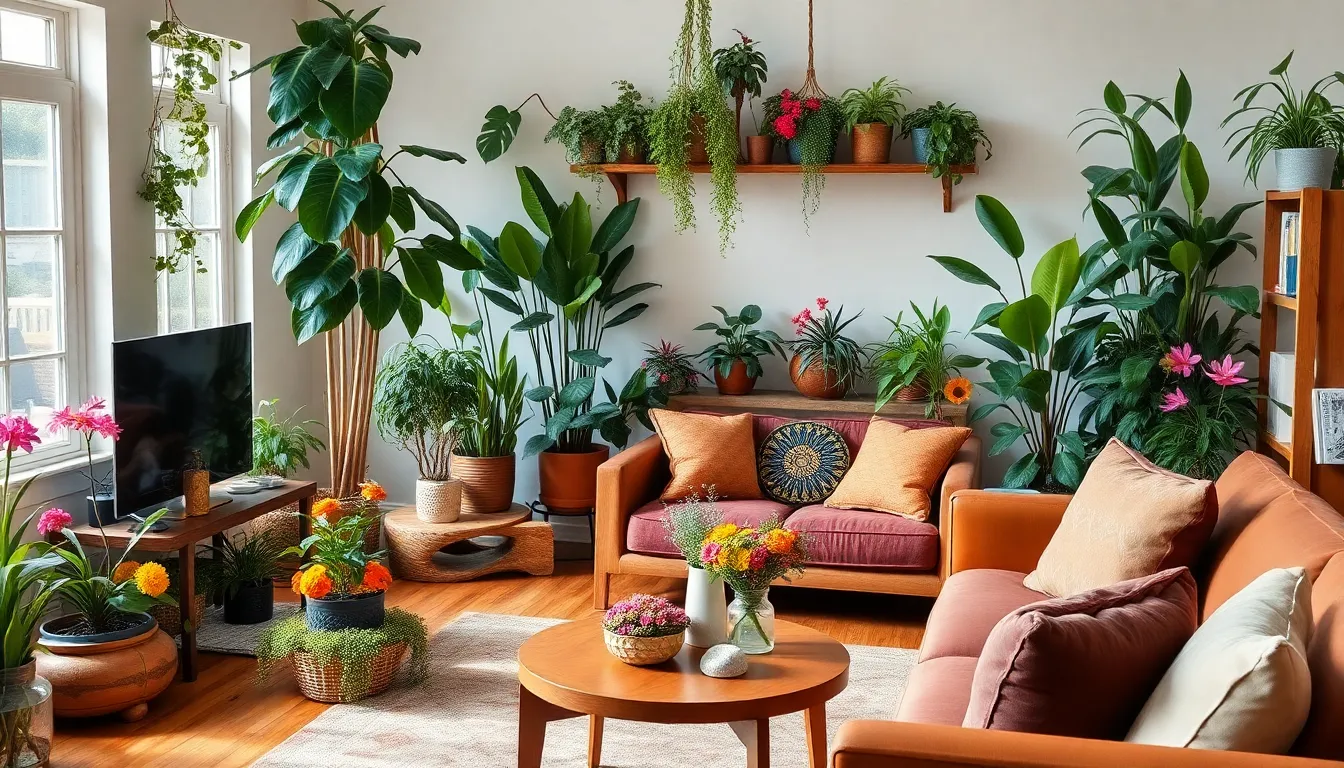
We can transform our living room into a vibrant sanctuary by introducing nature’s elements that create harmony between indoor and outdoor spaces. Natural elements instantly refresh our home’s atmosphere while supporting the trending earthy aesthetic that defines contemporary design.
Choose Low-Maintenance Indoor Plants
Select resilient varieties that thrive with minimal attention to maintain our busy lifestyles. Snake plants, pothos, and succulents require watering only once or twice weekly while continuously purifying our indoor air. These hardy options forgive occasional neglect and provide consistent green beauty throughout the year.
Position plants strategically near windows for optimal light exposure without overwhelming our room’s layout. Corner placements work particularly well for larger floor plants like fiddle leaf figs, while smaller varieties enhance coffee tables and shelving units. Multiple plants at varying heights create visual layers that draw the eye upward and make our space feel more ever-changing.
Group plants in odd numbers to achieve a more natural and visually appealing arrangement. Three or five plants clustered together create focal points that feel intentional rather than scattered throughout our living area.
Incorporate Natural Materials Like Wood and Stone
Choose wooden furniture pieces that showcase craftsmanship and add warmth to our living space. Artisanal wooden coffee tables, side tables, and shelving units support the 2025 trend toward conscious consumerism while introducing rich textures. Handcrafted pieces from small businesses offer unique character that mass produced items can’t replicate.
Add stone accent pieces strategically to create grounding elements that connect us with nature’s stability. Stone sculptures, decorative bowls, or accent walls provide textural contrast against softer furnishings. These elements complement the earthy color palette of warm browns, deep greens, and soft beiges that define current design trends.
Layer different natural textures throughout our room to build visual depth and tactile interest. Rough hewn wood paired with smooth river stones creates compelling contrasts that keep our eyes engaged while maintaining the organic theme.
Add Fresh Flowers for Seasonal Color
Rotate seasonal blooms to keep our living room feeling current and connected to nature’s changing rhythms. Spring tulips, summer sunflowers, autumn chrysanthemums, and winter evergreen branches each bring distinct energy and fragrance to our space. This practice ensures our room never feels stagnant or outdated.
Use varying vase heights to create ever-changing arrangements that complement our existing decor. Tall floor vases anchor corners while shorter arrangements on side tables provide intimate touches. Clear glass vessels allow stems to become part of the design while colored ceramics add artistic elements.
Position floral arrangements where natural and artificial lighting can highlight their beauty throughout the day. Side tables near windows capture morning light while coffee table centerpieces benefit from our layered lighting design during evening hours.
Organize and Style with Smart Storage Solutions
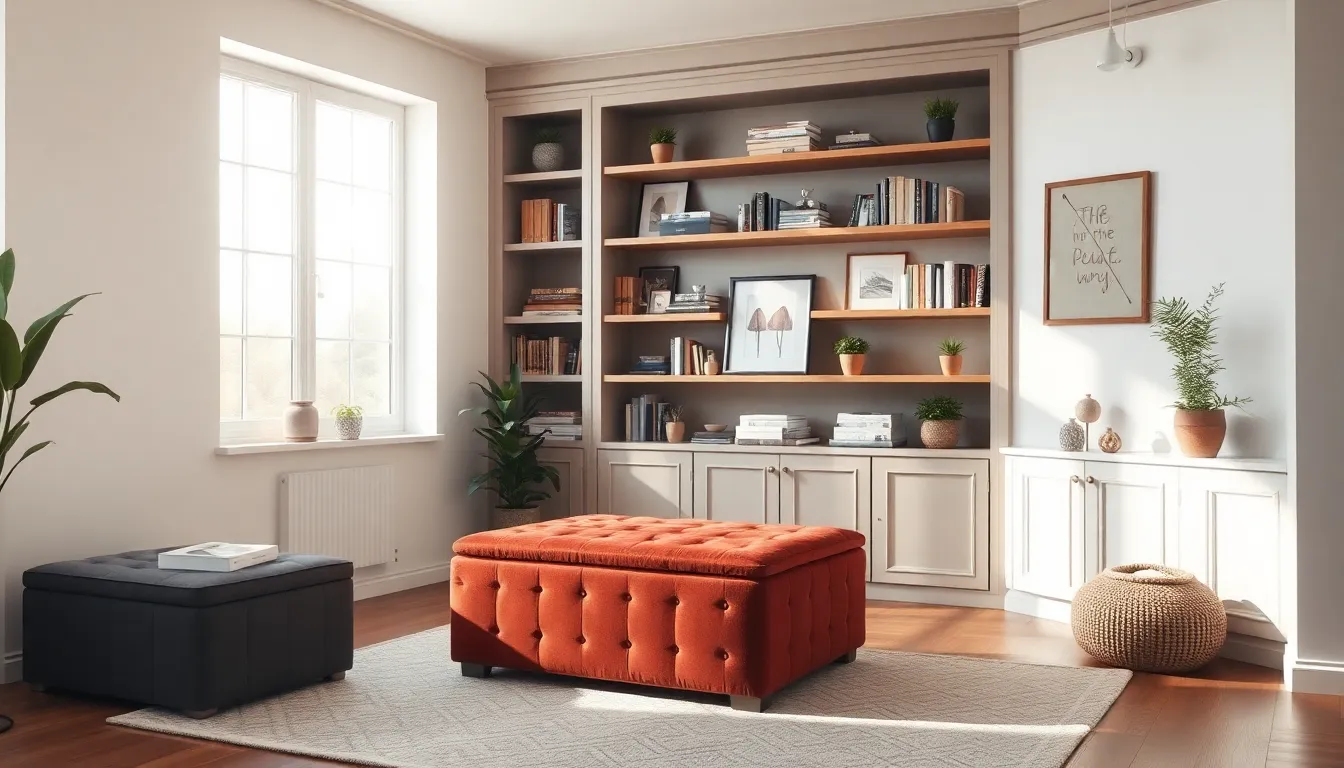
Creating a beautiful living room goes beyond selecting the right colors and lighting—we need smart storage answers that seamlessly blend function with style. These strategic storage choices help maintain the serene atmosphere we’ve carefully crafted while keeping our space organized and clutter-free.
Hide Clutter with Stylish Storage Ottomans
Storage ottomans transform our living spaces by serving dual purposes as both seating and hidden storage compartments. We can discreetly tuck away blankets, magazines, toys, and remote controls inside these versatile pieces while maintaining our room’s visual appeal. Modern ottomans come in various textures like velvet, leather, and woven fabrics that complement our existing color schemes.
Artisanal and handcrafted ottomans add unique personality to our spaces while providing practical storage answers. We can choose from round, square, or rectangular shapes to fit our furniture arrangement perfectly. Placing a storage ottoman near our sofa creates convenient access to stored items while offering extra seating for guests.
Use Built-in Shelving for Books and Decor
Built-in shelving maximizes our vertical wall space while creating organized displays for books, decorative items, plants, and art pieces. These custom storage answers can be designed to match our living room’s palette, particularly the popular earthy tones like warm browns, deep greens, and soft beiges that dominate 2025 trends.
Floor-to-ceiling shelving creates dramatic visual impact while providing extensive storage capacity for our belongings. We can arrange books alongside decorative objects in odd-numbered groupings to maintain visual interest. Strategic placement of plants and artwork on these shelves adds layers of texture and color that enhance our room’s character.
Floating shelves offer a lighter alternative to built-in units while maintaining functionality and style. We can install these at varying heights to create ever-changing wall compositions that complement our gallery walls or accent features.
Carry out Dual-Purpose Furniture Pieces
Coffee tables with hidden storage compartments serve as perfect examples of dual-purpose furniture that saves space without sacrificing style. We can store throws, board games, or extra pillows inside while using the surface for daily essentials like books and beverages. These pieces support the growing trend of combining comfort with unique, personalized design choices.
Sofas with under-seat drawers provide extensive storage while maintaining their primary seating function. We can store seasonal items, extra linens, or entertainment accessories in these hidden compartments. Side tables that double as storage units offer additional surface space while concealing smaller items we want to keep within reach.
Storage benches placed near windows or entryways create functional seating while housing shoes, seasonal decor, or reading materials. We can choose designs that complement our existing furniture while adding practical storage capacity to our living rooms.
Personalize Your Space with Meaningful Accessories
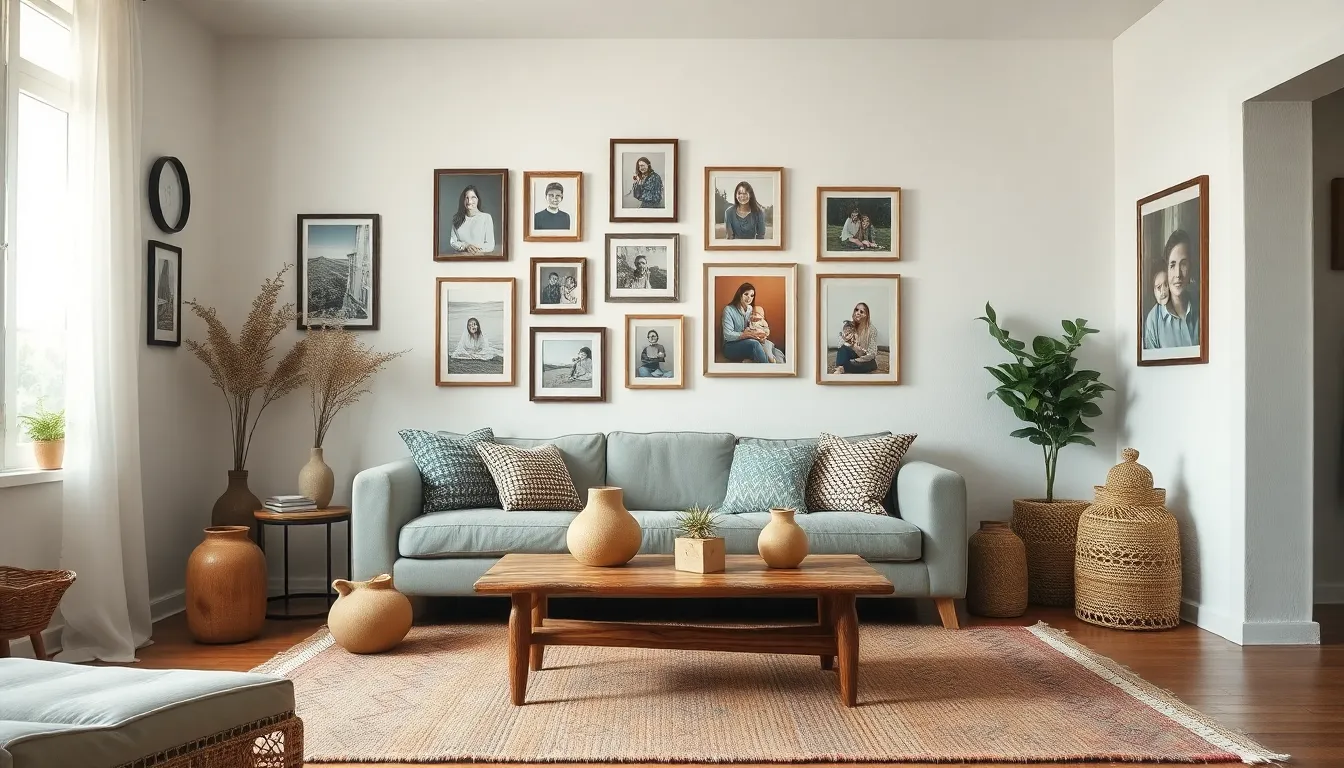
Smart storage answers create the foundation for beautiful organization, but meaningful accessories transform your living room into a personal sanctuary. Personalizing your space goes beyond trendy decor pieces to showcase the stories and experiences that define your home.
Display Collections and Travel Souvenirs
Collections transform empty surfaces into conversation starters that reflect your unique interests and adventures. Whether you’ve gathered vintage books, ceramic pottery, or unique figurines over the years, grouping similar items creates visual impact while telling your personal story. Travel souvenirs add character and spark meaningful conversations when guests visit your home.
Creating designated display areas for your collections prevents clutter while highlighting pieces you love most. Floating shelves work perfectly for smaller items like pottery or collectible figurines, while console tables provide space for larger travel memorabilia. We recommend arranging items in odd numbers and varying heights to create visual interest without overwhelming the space.
Travel keepsakes deserve special attention since they represent experiences and memories from your adventures. Consider dedicating a bookshelf section to items from different destinations, mixing photographs with small artifacts or souvenirs that capture each location’s essence. These personal touches add authenticity that mass-produced decor simply can’t match.
Add Family Photos in Coordinated Frames
Family photos create warmth and foster a sense of home by celebrating shared memories throughout your living space. Coordinated frames unify your photo display while allowing the images themselves to take center stage. We suggest choosing frames in the same material or color family to create cohesion without being too matchy.
Gallery walls featuring family photos work beautifully above sofas or along stairway walls where they’re easily visible. Mix different sized frames within your coordinated collection to create visual rhythm and accommodate various photo dimensions. Black frames offer timeless elegance, while natural wood frames add warmth that complements earthy color palettes trending in 2025.
Rotating seasonal family photos keeps your display fresh and current while honoring both recent memories and cherished moments from the past. Consider including photos from family vacations, holidays, and milestone celebrations that represent your family’s journey together. These personal elements contribute to an inviting atmosphere that makes both family and guests feel welcomed.
Include Handmade or Vintage Pieces
Handmade pieces offer distinct craftsmanship that supports sustainable practices while adding unique character to your living room. Artisanal decor carries stories and enhances individuality in ways that mass-produced items cannot replicate. We encourage incorporating handwoven rugs, ceramic vases, and wooden sculptures that showcase traditional craftsmanship techniques.
Vintage pieces bring history and personality into modern living spaces while supporting conscious consumerism trends. Antique furniture, vintage textiles, and retro accessories create focal points that spark conversation and add visual depth. These elements align perfectly with 2025’s emphasis on bespoke interiors that reflect personal taste rather than following generic design formulas.
Mixing handmade and vintage items with contemporary pieces creates an eclectic, curated feel that appears collected over time. Consider visiting local artisan markets, estate sales, and vintage shops to discover one-of-a-kind pieces that speak to your personal style. These meaningful additions transform your living room from a decorated space into a reflection of your values and aesthetic preferences.
Conclusion
Your living room transformation doesn’t have to happen overnight or expensive. We’ve shared proven strategies that work for any space size or budget whether you’re drawn to minimalist elegance or cozy eclectic charm.
Remember that the best living rooms reflect your personality while serving your family’s daily needs. Start with one element that excites you most—perhaps a bold color scheme or a statement piece of furniture—then build from there.
The key is creating a space where memories unfold naturally. Trust your instincts mix textures thoughtfully and don’t forget that even small changes like adding plants or rearranging furniture can make a dramatic difference. Your perfect living room is waiting to be discovered.
Frequently Asked Questions
What is the most important factor when decorating a living room?
Choosing a cohesive color scheme is crucial for transforming your living room into a personalized sanctuary. Start with a neutral foundation and add bold accent colors, or create dramatic combinations. Consider color psychology – warm colors encourage social interaction while cool tones promote relaxation.
How can I maximize natural light in my living room?
Layer your lighting design with multiple sources including natural light optimization. Use appropriate window treatments that allow light while maintaining privacy. Combine overhead lighting, table lamps, and floor lamps to create an inviting atmosphere throughout different times of day.
What’s the best way to arrange furniture in a living room?
Create a functional layout that promotes conversation and natural flow. Maintain optimal distances between seating elements and ensure clear pathways throughout the space. Position furniture to encourage interaction while keeping traffic patterns unobstructed for both functionality and safety.
How do I add visual interest without overwhelming the space?
Incorporate texture and pattern strategically by mixing fabric textures and layering rugs to define different areas. Use wall decor like gallery walls and floating shelves for both storage and display. Add statement wallpaper or paint techniques to create focal points without cluttering.
What storage solutions work best for living rooms?
Invest in dual-purpose furniture like storage ottomans that provide seating and hidden storage. Use built-in shelving to maximize vertical space for books and decor. Choose coffee tables and sofas with hidden compartments to maintain organization while preserving your room’s aesthetic appeal.
How can I personalize my living room on any budget?
Display meaningful collections, travel souvenirs, and family photos in coordinated frames to create warmth and reflect your personality. Incorporate handmade and vintage pieces for unique character. Create designated display areas to prevent clutter while showcasing items that tell your story.
What role do plants play in living room design?
Plants and natural elements enhance atmosphere and air quality while adding life to your space. Choose low-maintenance indoor plants that suit your lighting conditions. Incorporate natural materials like wood and stone to create a balanced, organic feel that connects your interior with nature.







